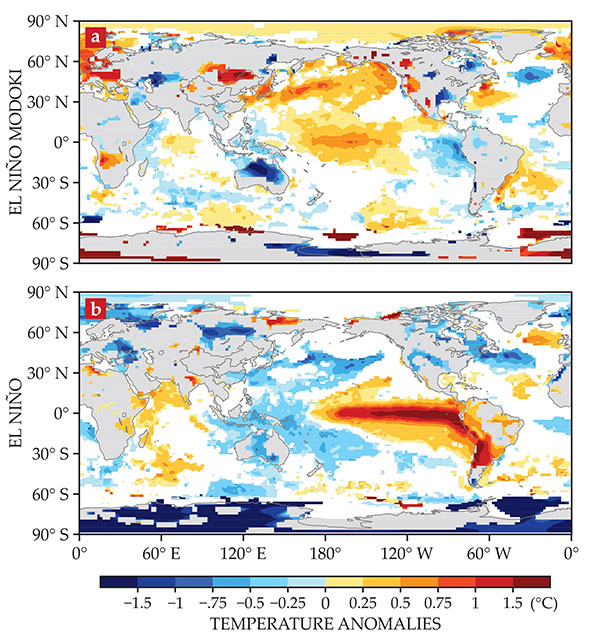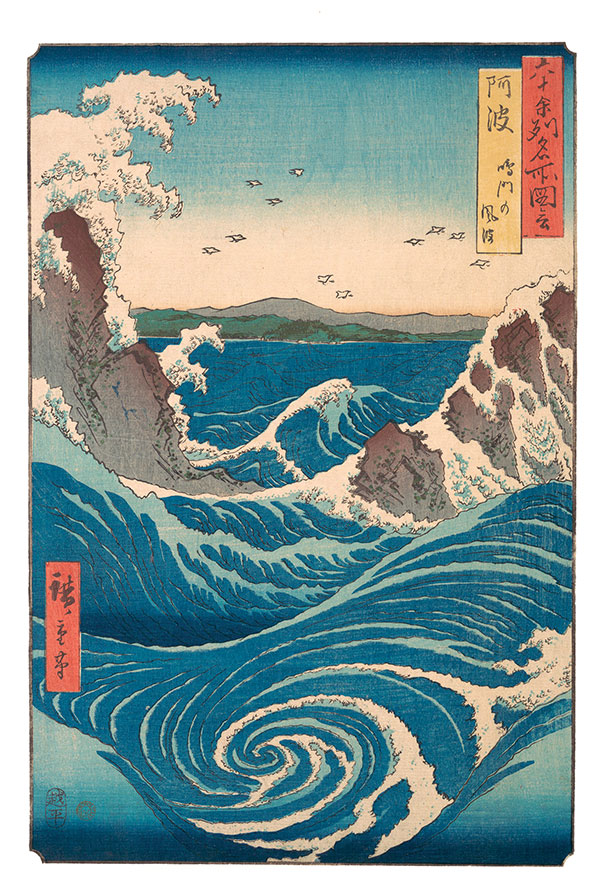A new type of tropical Pacific warming—El Niño Modoki
DOI: 10.1063/PT.3.4092
This past April Physics Today challenged readers to send us essays about a discovery made in the 21st century that deserves to be more widely known. We received a total of 24 entries. This is the prize-winning entry.
In the climate community, it is widely known that the El Niño–Southern Oscillation (ENSO) is the strongest source of Earth’s climate variability. The ENSO is manifested as anomalous sea-surface temperatures (SSTs) and anomalous sea-surface pressures over the equatorial Pacific Ocean. The anomalies have influence worldwide on temperatures and precipitation, which in turn have dramatic societal consequences for agriculture, public health, marine ecosystems, and other entities.
A period with unusually warm SSTs is termed El Niño; the cool phase is termed La Niña. Both El Niño and La Niña events typically last around a year and peak during boreal winter—that is, in December. The ENSO cycle is irregular, and warm and cool phases generally alternate between two and seven years. Even though El Niño was recognized by fishermen living off the South American coasts during the 1600s, the scientific understanding of the ENSO was established, and the successful attempt to forecast the next El Niño was realized, only in the 20th century.
Sailors noticed one manifestation of El Niño, a warm, northward current off Peru, in the 19th century. Because the current appeared around Christmas, they named it “the Child.” In the 1920s Gilbert Walker identified the oscillatory nature of atmospheric pressure over the equatorial Pacific, now known as the Southern Oscillation. In the 1960s and 1970s, Jacob Bjerknes proposed that oscillation is driven by the interaction between the equatorial trade winds (or Walker circulation) and ocean circulation. 1 In the 1980s Mark Cane and Stephen Zebiak were the first to come up with a climate model that successfully predicted the 1986 and subsequent El Niño events. 2 , 3
Despite evidence that ENSO conditions have recurred for at least 130 000 years, the 20th century is when the science of understanding and predicting the ENSO advanced significantly. Given its importance on the global climate, the ENSO has been a prominent discussion topic in the scientific community, in the media, and, indeed, in this magazine. (See David Neelin and Mojib Latif’s article, “El Niño dynamics,” Physics Today, December 1998, page 32
Such intense interest in the ENSO prompted researchers to study the tropical Pacific SST characteristics and the ENSO’s climatic impacts across multiple years. Although individual El Niño events differ, it appears that the events share warm SST anomalies that generally occupy the eastern and central equatorial Pacific. Meteorologists call that condition the canonical, the conventional, or the eastern-Pacific El Niño.
The bigger picture
During the 2000s some scientists found it peculiar that during some years, particularly after the 1970s, warm SST anomalies were found only over the central equatorial Pacific; further, that zone of warm water was flanked by cool SST anomalies at the western and eastern Pacific. Also peculiar was the fact that the global climatic impacts exerted by such central Pacific warming differed from those exerted by the canonical El Niño.
Those differences are strong enough to necessitate designating an additional type of El Niño (see

Combined Boreal summer anomalies over oceans and skin temperature anomalies over land for the three El Niño Modoki events of 1994, 2002, and 2004 (a) and for the three canonical El Niño events of 1982, 1987, and 1997 (b). (Adapted from ref.

Like the canonical El Niño, El Niño Modoki influences the global climate system and global society. Given that the new variant was discovered only a decade ago, members of the general public might be unaware that the ENSO can exist in two flavors. Nonetheless, the discovery of El Niño Modoki in the 2000s was an important advance in strengthening our understanding of Earth’s climate variability across specific parts of the world.
Due to the different equatorial Pacific SST anomaly patterns between canonical El Niño and El Niño Modoki events, their atmospheric responses to the SST anomalies differ. During a canonical El Niño, an anomalous Walker circulation cell extends across the entire equatorial Pacific, with the uprising convective branch located over the warm waters off the eastern Pacific, resulting in wetter conditions in the east but drier conditions in the west. However, during an El Niño Modoki, two anomalous Walker cells extend over the entire equatorial Pacific, with both of their uprising branches located over the warm waters of the central Pacific, resulting in wetter conditions in the center but drier conditions to the east and west. Moreover, while the canonical El Niño matures during the boreal winter, the El Niño Modoki can peak at both boreal summer and boreal winter. 4 Hence, the different atmospheric responses of the El Niño types lead to different seasonal climatic impacts across the world.
To illustrate the differences in more detail, let’s use the boreal summer over the Pacific Rim as an example. Under the influence of a canonical El Niño, western North America and southern Japan tend to experience cooler temperatures and more rainfall and flooding. By contrast, El Niño Modoki brings dry and warm conditions across western North America, Japan, and Australia. 7
El Niño Modoki in the 21st century
Observational data reveal that the frequency and intensity of El Niño Modoki events significantly increased after the 1970s. Before then, they were relatively weak and short-lived. A study over the 1854–2007 period 8 noted that the annual probability of a central-Pacific El Niño event occurring before 1990 was about 1%. After 1990 it increased to 30%. By contrast, the annual probability of an eastern-Pacific El Niño occurring before 1990 was about 20%. After 1990 it rose to the same value as for El Niño Modoki, 30%, but by a much smaller factor. The two trends mean that not only have more El Niño Modoki events happened recently, but also both canonical El Niño and El Niño Modoki events have recurred at the same rate since the 1990s.
Two main hypotheses have been proposed to explain the increasing occurrence of El Niño Modoki. The first evokes climate change. Based on model simulations, some analyses showed that significant anthropogenic global warming after the 1970s has led to weakened equatorial trade winds and thus the shallowing and zonal flattening of oceanic thermocline across the equatorial Pacific. 8 A shallower, zonally flatter thermocline enhances the SST anomaly off the central Pacific that favors the development of El Niño Modoki. Most of the models based on climate-change scenarios predict that more El Niño Modoki than canonical El Niño events will occur in the future. 8

Naruto Whirlpool, Awa Province, Utagawa Hiroshige, woodblock print c.1853. (Rogers Fund, 1919.)

The second hypothesis proposes that natural decadal–centennial climate variability is responsible for the increased occurrence of El Niño Modoki. Some scientists assert that the remote forcing by warm subtropical Pacific SSTs induces weaker trade winds that facilitate warming over the central Pacific and development of El Niño Modoki. 9 Internal variability in the subtropical Pacific climate system could modulate the occurrence rate of El Niño Modoki. Also, multicentennial variations in the ratio between central-Pacific and eastern-Pacific El Niño events were detected in a model simulation run. 10
Proponents of the natural variability hypothesis argue that we just happen to be in the phase of high El Niño Modoki activity, which is not related to climate change. Given the lack of a consistent physical explanation behind the recent increase of El Niño Modoki events, meteorologists still need to continue to carefully examine the cause.
Nevertheless, observations have established that more El Niño Modoki events happened in recent decades, especially at the start of the 21st century. We can reasonably expect to see more of them, at least in the near future. The next step is to continue efforts to understand the mechanisms that drive El Niño Modoki, which is currently less predictable than the canonical El Niño. 11 Better predictability will allow meteorologists to better forecast the next El Niño Modoki and prepare humankind for its climatic repercussions. They will likely be dramatic.
References
1. J. Bjerknes, Mon. Weather Rev. 97, 163 (1969). https://doi.org/10.1175/1520-0493(1969)097<0163:ATFTEP>2.3.CO;2
2. M. A. Cane, S. E. Zebiak, Science 228, 1085 (1985). https://doi.org/10.1126/science.228.4703.1085
3. M. A. Cane, S. E. Zebiak, S. C. Dolan, Nature 321, 827 (1986). https://doi.org/10.1038/321827a0
4. K. Ashok et al., J. Geophys. Res. Oceans 112, C11007 (2007). https://doi.org/10.1029/2006JC003798
5. H.-Y. Kao, J.-Y. Yu, J. Clim. 22, 615 (2009). https://doi.org/10.1175/2008JCLI2309.1
6. J.-S. Kug, F.-F. Jin, S.-I. An, J. Clim. 22, 1499 (2009). https://doi.org/10.1175/2008JCLI2624.1
7. H. Weng et al., Clim. Dyn. 29, 113 (2007). https://doi.org/10.1007/s00382-007-0234-0
8. S.-W. Yeh et al., Nature 461, 511 (2009). https://doi.org/10.1038/nature08316
9. J.-Y. Yu, H.-Y. Kao, T. Lee, J. Clim. 23, 2869 (2010). https://doi.org/10.1175/2010JCLI3171.1
10. S.-W. Yeh et al., Geophys. Res. Lett. 38, L02704 (2011). https://doi.org/10.1029/2010GL045886
11. K. Ashok, T. Yamagata, Nature 461, 481 (2009). https://doi.org/10.1038/461481a
More about the Authors
Marvin Seow a is doctoral student in the department of Earth and planetary science at the University of Tokyo in Japan.





